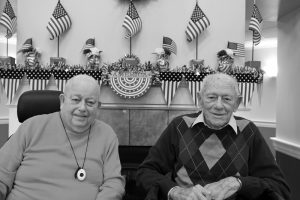World War II didn’t just change the lives of service members. Everyone on the home front, too, found their lives altered in ways big and small.
In some ways, “people in Ohio had it comparatively good,” said Walter Grunden, a history professor at Bowling Green State University. It wasn’t like the West Coast where people feared an attack by the Japanese, or the East Coast where they worried about German U-Boats in the Atlantic.
Nevertheless, the war made its presence known every day — through rationing, victory gardens and the changing role of women.
University of Findlay history professor Mark Polelle said after the terrorist attacks of Sept. 11, 2001, most Americans still went about their normal lives. During World War II, though, “everyone on the home front is integrally involved in the war.”

Marie Foust, now 100, was 22 when the war began. She was ironing when she heard a radio report on the attacks at Pearl Harbor. “I thought, ‘Oh, my goodness.’”
Foust, a 1937 Van Buren High School graduate now living in Findlay, lived in Cleveland and Columbus in the 1940s, where she was one of many women who took on what had been considered men’s work.
With the men off at war, “The women just filled in,” she said. “And they were quite good.”
During the war, Foust worked for Chase Brass Co. in Cleveland, running a crane which gathered lead and zinc to make brass. She earned time and a half for working Saturdays and double time on Sundays.
Later, she got a job as a secretary at Columbus Testing Laboratories, where she learned to use a lathe and drill press.
But she only made it half a day in her one factory job, at Timken Roller Bearings. There, she picked up ball bearings off a belt coated in oil.
“You smell that oil. … By noon, I was sick. … I admire anyone that works in a factory,” she said.
The crane, by contrast, “wasn’t too hard,” she said. There was a “hookup man” on the bottom directing her. They’d load the car full of lead, zinc or both, lift it up and put it in a furnace. Atop the crane, she could look down and see everything.
“I had my lunch up there,” she said.
However, after she was asked to cross from one crane to another on a steel beam, she hoped she wouldn’t be asked to do it again. She made it across, thinking, “Don’t look down.”
Joy Bennett, curator/archivist at the Hancock Historical Museum, said the women taking on all these jobs were just average women, who got up “very, very early” to care for their children and — in the case of farm women — animals. They’d go to work wearing men’s coveralls, with their hair up in a kerchief like the iconic Rosie the Riveter, and then they would rivet or weld.
Before that, women had held office jobs and worked as librarians or teachers, but other than on farms, they did not usually do physical labor.
Propaganda posters and films of the time stressed that this wartime work was similar to what was already considered “women’s work,” said Sarah Myers, assistant professor of history at Messiah College in Pennsylvania. They might describe how operating a drill press was really “the same as squeezing orange juice in your home,” or how cutting out the door of an airplane was like cutting out a sewing pattern for a dress.
Myers said women who worked as Rosies have said it gave them a “newfound sense of what they were capable of.” And working-class women, who had actually been in the workforce all along, were now earning higher pay and doing more skilled labor. She said women talked about being excited that, for example, “I just put this ship together” and it floats.
Katherine Landdeck, associate professor of history at Texas Woman’s University, said the women prominent in World War II were young, in their 20s.
“They had grown up knowing they had the right to vote. … They had a different mindset from birth,” she said.
She said one reason the Allies won World War II was all of the items for the war that were built in American factories. And it was women who did the majority of that work.
Myers said women involved later in the women’s liberation movement would reference the women of World War II. Myers once wrote an article about the fact that that famous poster of Rosie the Riveter, where she’s flexing her muscles, wasn’t actually famous during the war. But decades afterward, the women’s movement used it as a symbol for women’s empowerment.
Bennett said many of the women returned to being homemakers after the war — but instilled in their own daughters a desire to do something more.
Foust said the world looks different for women today. When she was young, it wasn’t just that men doubted women’s ability to perform a man’s job well. Women themselves had more doubts, and were more “timid” back then, she said.
“Oh, I think it’s better now,” she said.
Women needed to work not only because the men were at war, but because the economy as a whole was growing.
“War is, sadly, good business,” Bennett said.
An army needs to be fed, clothed and armed, which means a lot of things need to be produced.
John Haas, manuscripts curator at Ohio History Connection, said Ohio had the fourth-highest amount of World War II contracts, behind Michigan, New York and California. During the war, “every manufacturer in the state boomed,” and people came in from other states to work in Ohio, he said.
Ohio produced synthetic rubber. Much of the rubber before then had come from the Dutch East Indies, which were captured by Japan in 1942. Ships and aircraft were built in Ohio. The coal-mining industry, too, increased coal production by 82 percent from 1939 to 1945.
Bennett said the Cooper Tire factory in Findlay manufactured floatation vests for pilots. The pilots referred to them as “Mae Wests” because of “how it ended up looking on the front.”
Agriculture boomed, as well. Haas said Ohio farmers had been hurt by the Great Depression but once the war began, they were needed to supply food to the war effort.
Communities rationed sugar and butter, “oh, just about everything,” Foust said. One day a week, citizens might be asked to abstain from eating beef, so that meat could go into the supply chain to be turned into tinned beef for soldiers.
“About everything was rationed. There used to be lines and lines of people” waiting, Foust said.
She recalled one time her mother sent her to North Baltimore to get butter, since they couldn’t get any in Van Buren. She arrived there to find a long line — and, because she wasn’t a North Baltimore resident, she couldn’t get any butter.
People were encouraged to plant “victory gardens” in their yards, growing vegetables to supplement the rations. Bennett said many women learned how to can to preserve food.
Coffee was rationed, too, Bennett said: “You’d have to reuse your grounds quite a bit.”

Veteran Ned Ammons married his wife, Ruth, while he was home on leave. Gasoline was being rationed, so it was only with the help of someone else chipping in ration tickets that the couple was able to get enough gas to go to Detroit for their honeymoon.
And women had to do without their stockings because nylon was needed for parachutes.
“Everyone wore silk hose,” Foust said. “You couldn’t buy them. So you used leg makeup.”
She said some women drew a seam up the back with an eyebrow pencil. But their legs got cold in the winter.
Bennett said even younger children were involved in the effort. There are pictures of 12-year-old boys picking up scrap metal in wagons, and the child who brought in the most scrap metal might win a prize.
“Essentially everybody pitched in,” she said.
Those on the home front also coped with worry about loved ones off at war.
“Almost every family had somebody gone,” Haas said. Missing your brother or husband or son “was a constant.”
Ammons, 96, served in the United States. He wasn’t sent overseas, because his three brothers were already there.
“I think his mother prayed a lot,” said Ruth.
Families sent care packages, which might include Hershey chocolate bars, Lucky Strike cigarettes and some form of alcohol, as well as magazines and hometown newspapers. Bennett said the Tasty Taters potato chip factory in Findlay made up packages of chips specifically for sending to soldiers.
People would get some news of the war on newsreels, but the military restricted a lot of information.
“They would get general news but not specifics,” Bennett said.
They wouldn’t know what had happened to their loved one until they received a letter or a telegram — but you didn’t want to receive a telegram, as that typically meant bad news.
Ken Lentz of Findlay, who was a prisoner of war in Germany during the war, shared with The Courier what his siblings had written about that experience. Months passed before they knew his fate or if he was even alive.
“Kenny was classified as missing in action and there had been no other news for nearly six months. … A glimmer of hope had arrived in a letter from a crewman who had been in another plane on the same mission. After Kenny’s plane exploded, a parachute was seen to open,” they wrote.
The community learned of service members’ fate in the newspaper, as well. Bill Rowe, at 92 the youngest of the veterans interviewed by The Courier, read about the war while still in high school.
“Every day you’d want to read the paper before you went to school,” he said. “And they used to publish the names of the people that … were killed. You know, since the last publication. And some of the people that I would see in there I knew — I knew well.”


